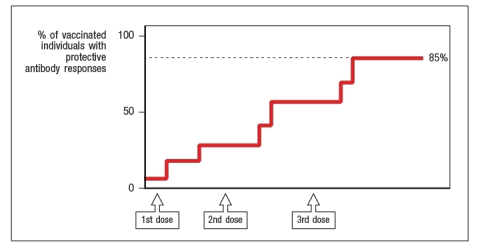Synthesis question: Several vaccines against viral infections are made by isolating purified surface proteins of the viral particle, mixing them with an adjuvant to stimulate an innate immune response, and injecting the mixture into people. Two examples of this are the vaccine against Hepatitis B virus, and the vaccine against Human Papilloma Virus (the 'cervical cancer' vaccine). One interesting property of vaccines of this type (known as 'subunit vaccines') is that there is a requirement for a CD4 T cell response to the vaccine antigen in order to generate antibodies to the innocuous protein in the vaccine. In the case of the Hepatitis B vaccine, the viral protein included in the vaccine is the Hepatitis B surface antigen (HepB-SAg), a protein that is approximately 200 amino acids in length. The graph in Figure shows the data from immunizing individuals with this vaccine, and monitoring their production of protective antibody responses to the viral protein. 
a) What results would be predicted if experiments were performed to examine the CD4 T cell responses to the HepB-SAg in these same individuals? In particular, indicate whether all individuals would show similar responses. Explain your reasoning.
b) Most vaccines, particularly those made by immunizing individuals with purified pathogen components, are designed to elicit robust antibody responses to the immunizing antigens. For vaccines against viral infections (like the HepB vaccine), the immune responses generated are only protective when administered prophylactically, i.e., before the individual is ever exposed to the pathogen. Why is it essential to vaccinate against viral infections before the individual is ever exposed to the virus?
Correct Answer:
Verified
View Answer
Unlock this answer now
Get Access to more Verified Answers free of charge
Q18:
Q19: The antibody surface involved in antigen binding
Q20: Antibody heavy and light chain polypeptides consist
Q21: One striking feature of TCR interactions with
Q22:
Q23: The cellular distribution of MHC class I
Q25: Synthesis question: For the last five years,
Q26: One strategy for vaccine development currently under
Q27: Hepatitis C is a virus that
Q28: T cells expressing
Unlock this Answer For Free Now!
View this answer and more for free by performing one of the following actions

Scan the QR code to install the App and get 2 free unlocks

Unlock quizzes for free by uploading documents